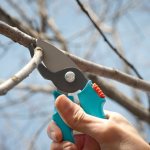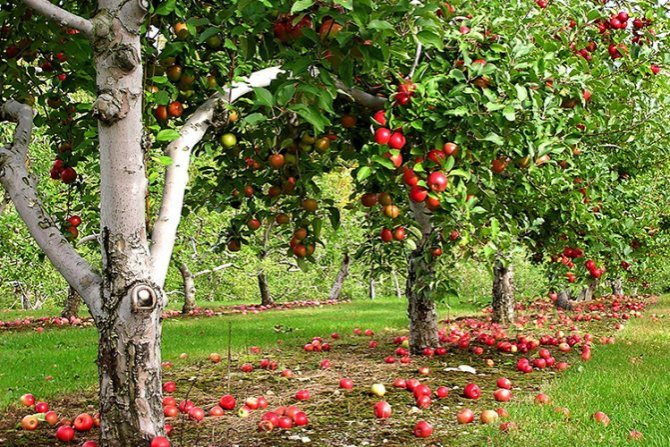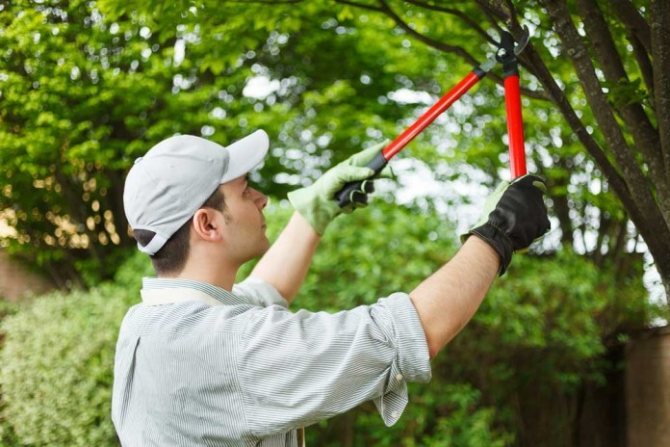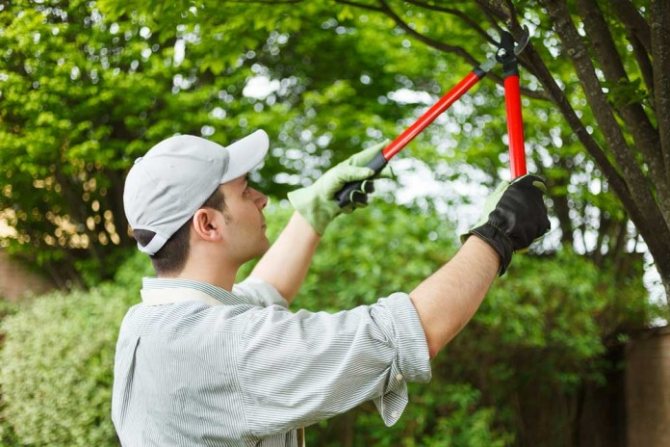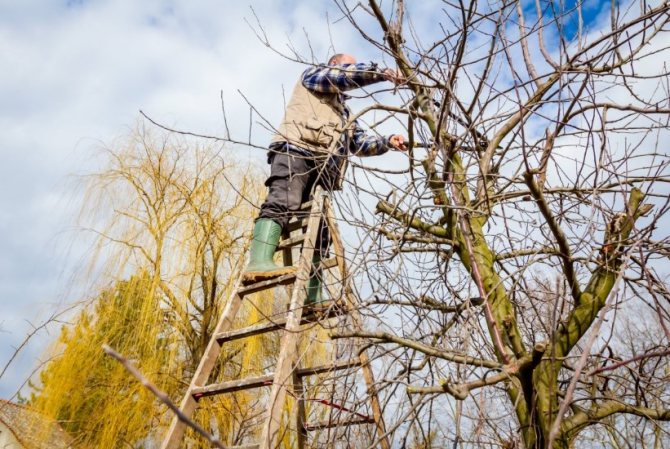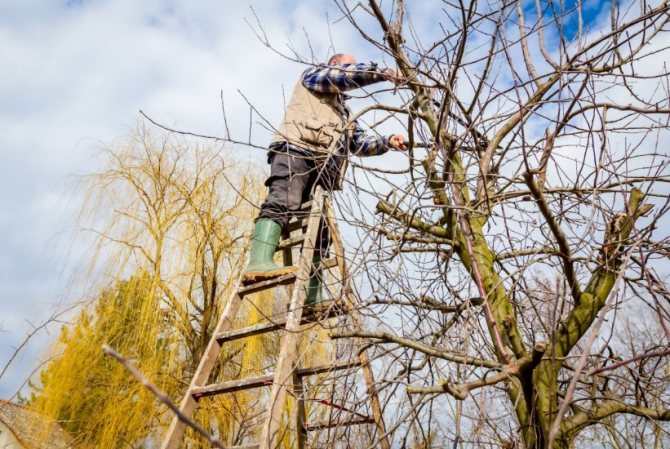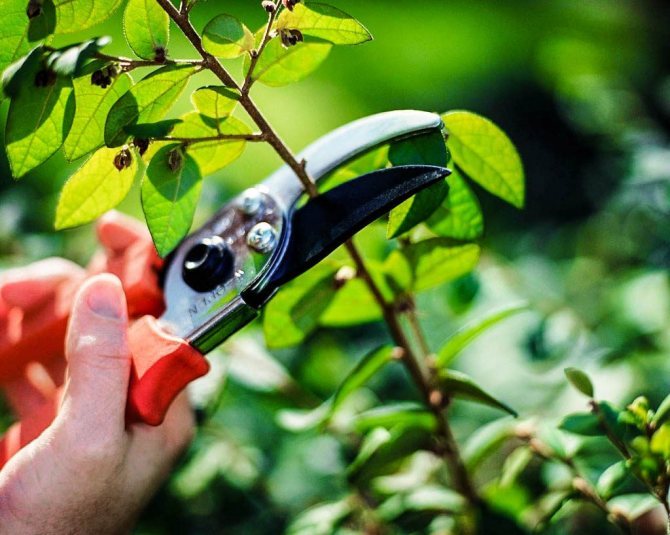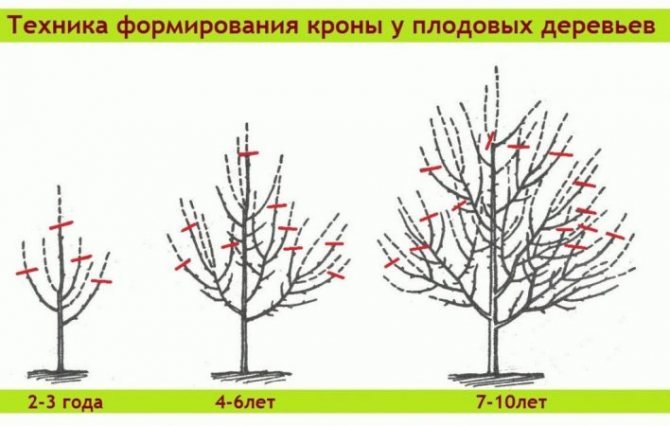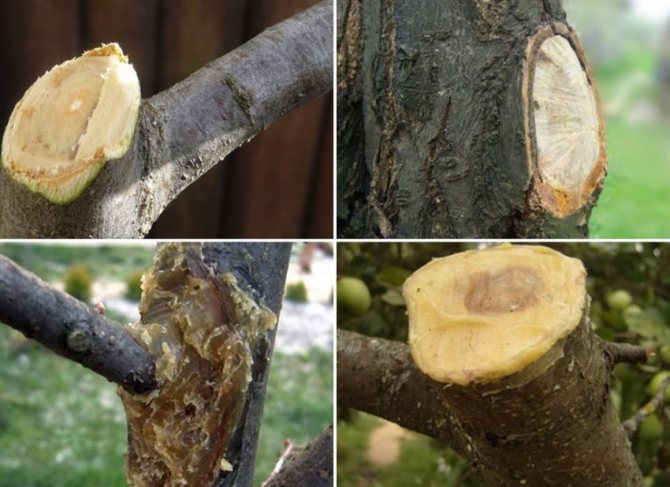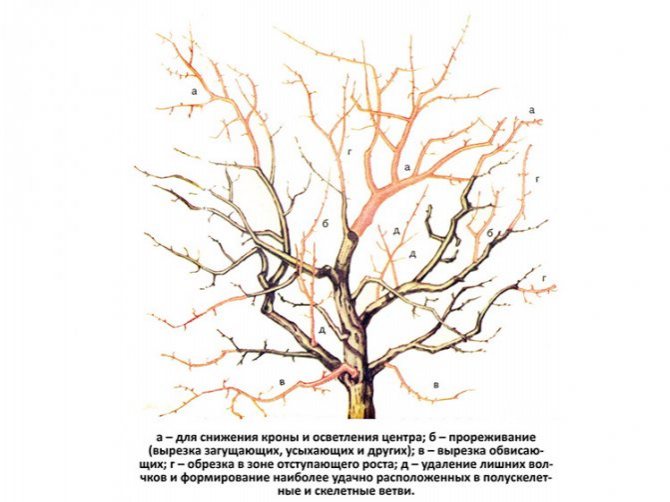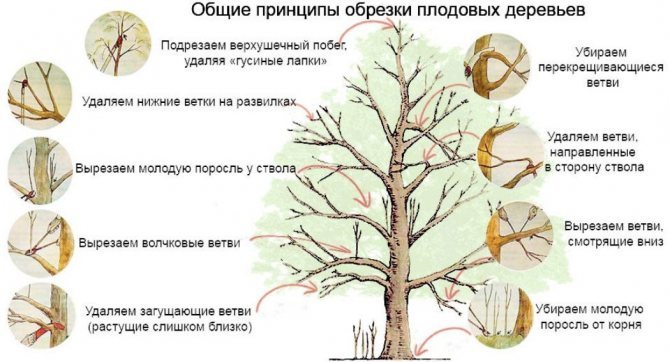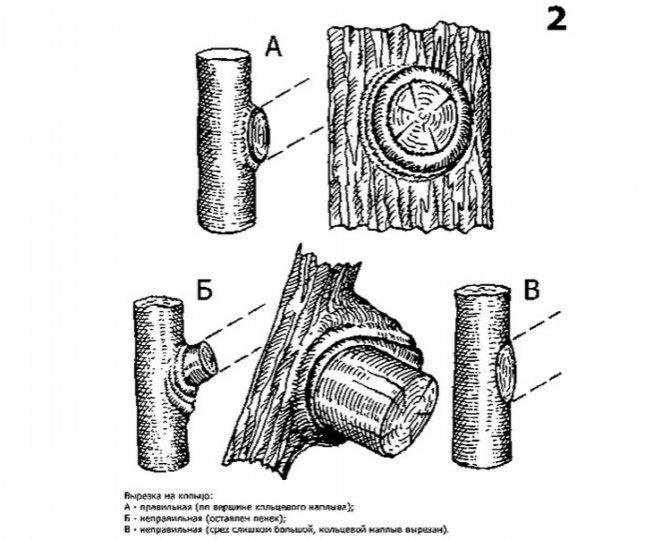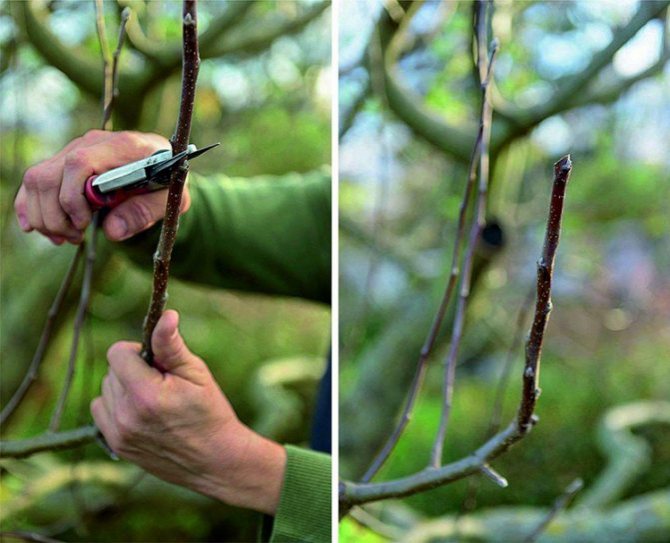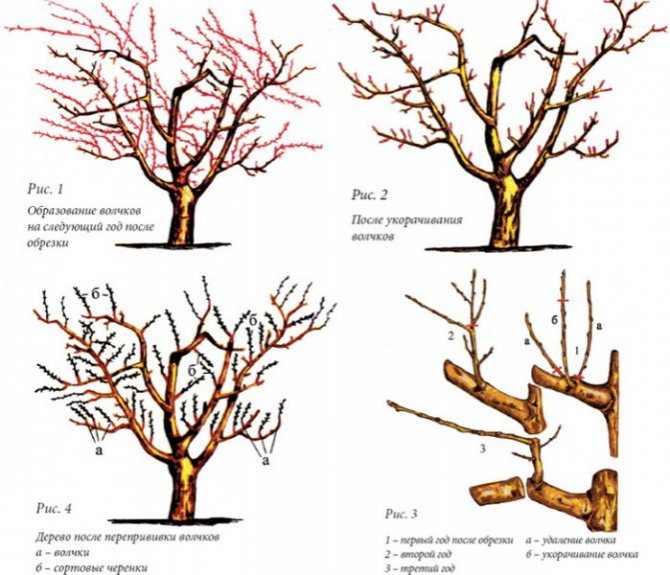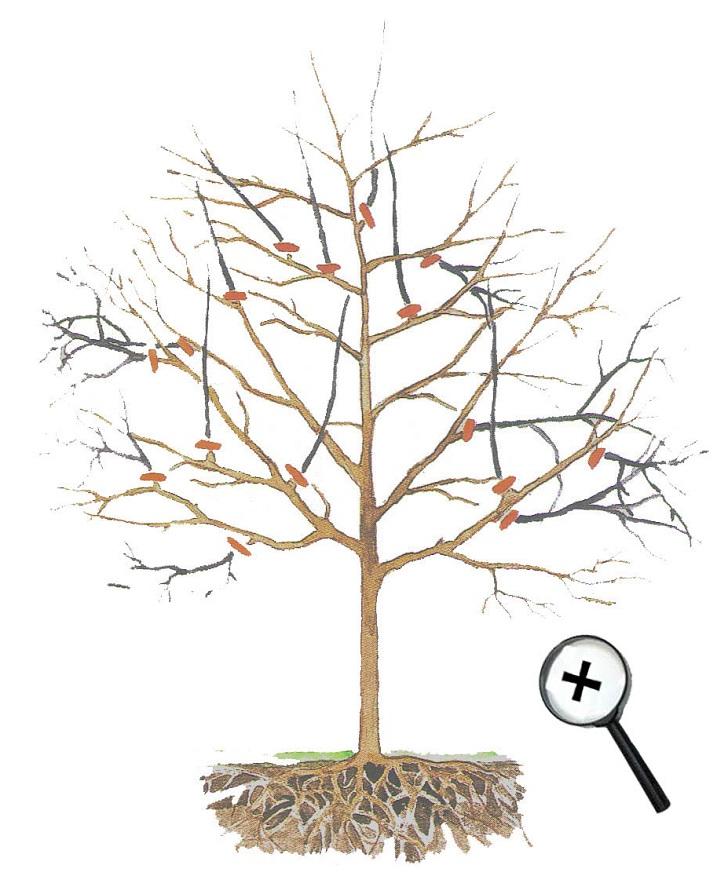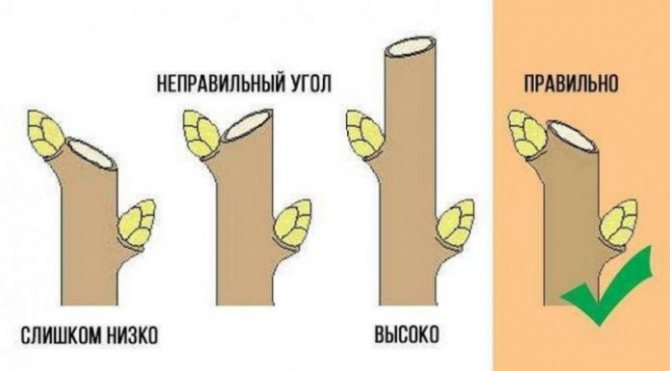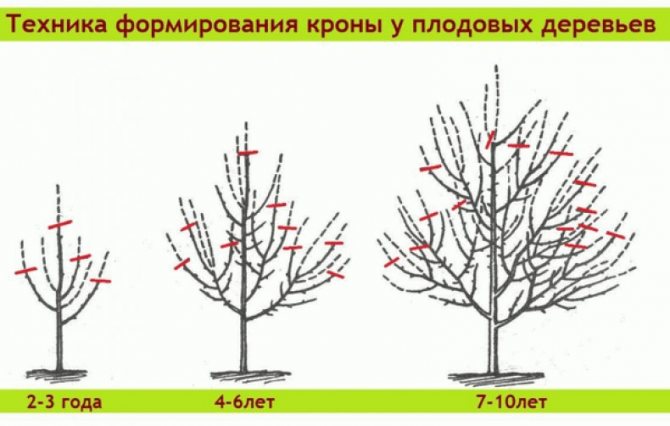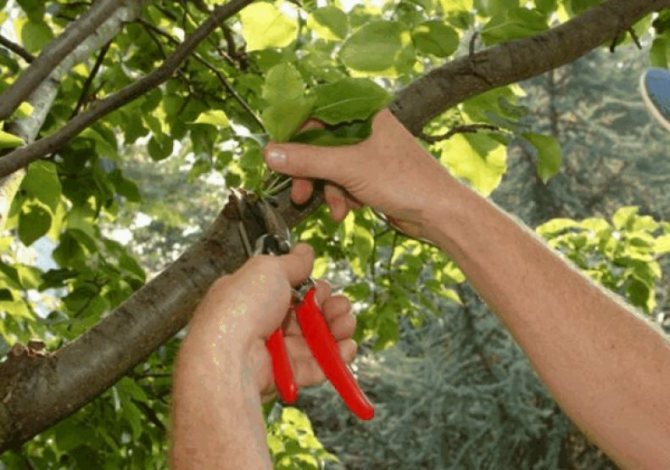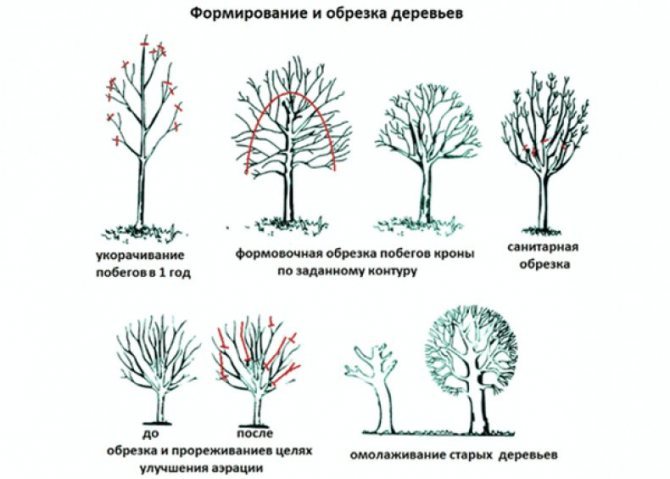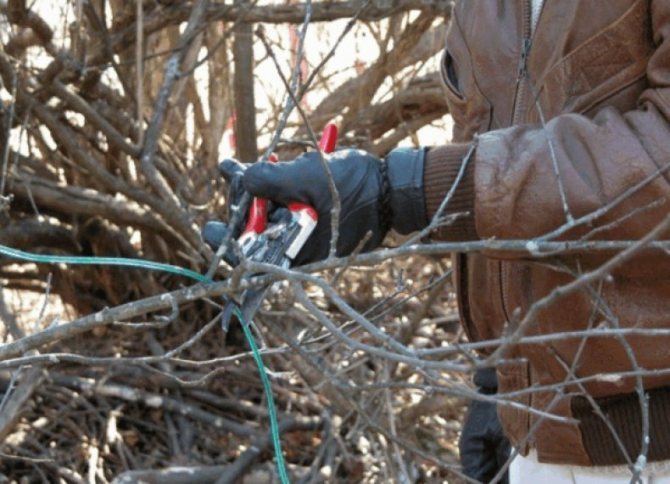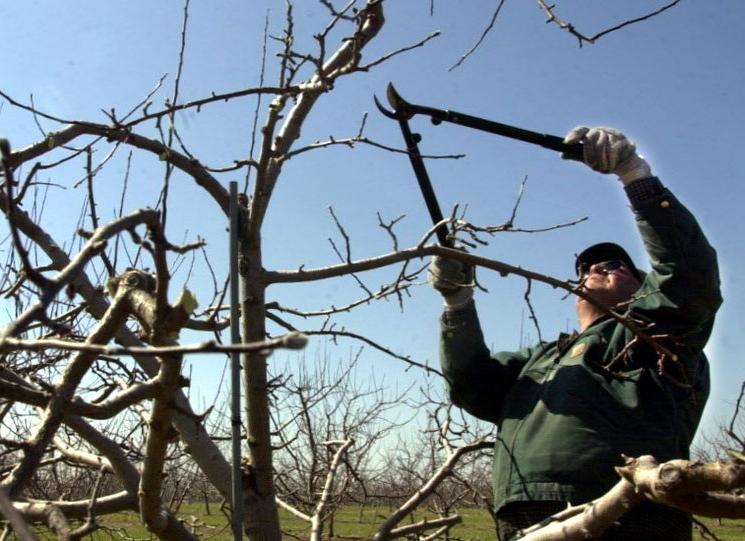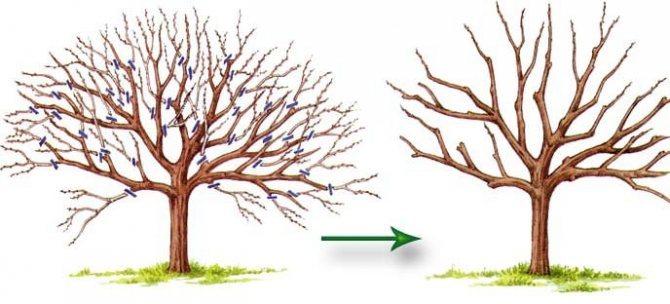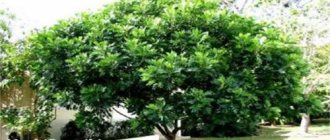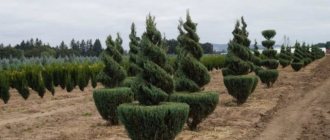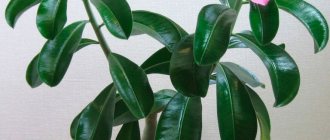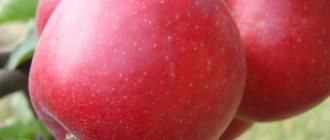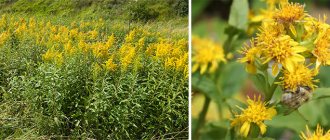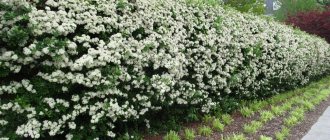Pruning trees in the fall is a very important process, which largely determines the health of the garden, its yield and longevity. Pruning can be carried out in spring and autumn, can be carried out with the aim of thinning the crown or rejuvenating for old fruit crops. We have to take into account their types and varieties so as not to harm the garden. It is also necessary to ensure that pruning is carried out before the start of sap flow in the spring and after it stops in the fall.
Timing of pruning trees in autumn
The autumn pruning procedure helps the trees to endure the winter cold more easily, and also has a very positive effect on the quality characteristics of the future harvest. But it must be carried out on time.
Gardening begins when nutrients are transferred from the leaves to the trunk and roots, that is, with the fall of the foliage. At this time, sap flow slows down, the tree prepares for rest, therefore it is least susceptible to injury.

Pruning tools
The tool recommendations are pretty straightforward. To properly prune trees and shrubs, buy the best tools you can afford and keep them in good condition.
Here are the basic tools:
- Pruner. The use of ratchet instruments is not recommended. It is best to choose a regular and comfortable pruner.
- Garden hacksaw. This is a specialized hacksaw that tapers towards the end of its blade. The teeth are designed to prevent the hacksaw from clogging up with sawdust. It is not recommended to use a construction hacksaw. For comfortable work, purchase a tool according to the profile.
- Air secateurs. This pruner is used for hard-to-reach areas of the tree. It is a bar on which a secateurs are attached, which is activated by a lever and a rope.
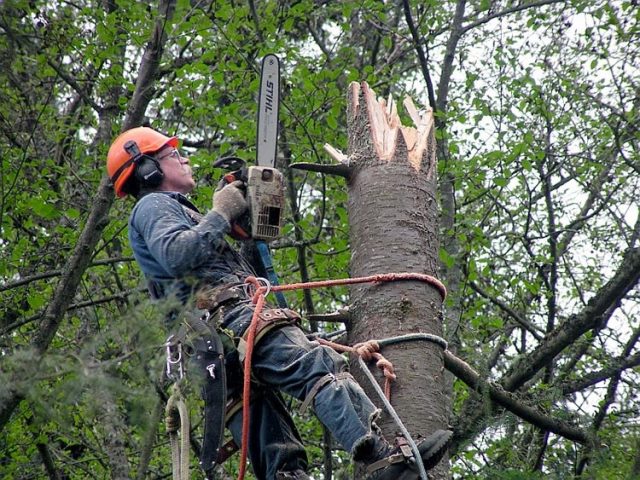

Pruning at height with special equipment
It is necessary to monitor the condition of the instrument. Sharp blades must be used to avoid damaging the trunk or bark. Otherwise, there is a risk of surfaces susceptible to contamination with harmful microorganisms. Tree diseases are easily spread by contaminated tools.
Therefore, after each trimming procedure, do not forget to disinfect your tools in a 1/9 chlorine / water solution, followed by cleaning with soapy water and then drying.
Recommendations for the circumcision process
Novice gardeners are interested in how to prune each specific tree, because the methods differ depending not only on the species, but also on the variety. For example, when pruning walnuts, mulberries and grapes, only dried shoots that interfere with growth are most often removed. Each vine requires active and painstaking attention. The pruning of stone fruits (cherries, cherries, apricots) begins with fruiting specimens in order to have time before the awakening of stone buds, which wake up earlier than vegetative ones.


Pruning trees in spring
One-year-old growths (last year's shoots) must be pruned every year or at least every other year. By combining tenderloin and pruning, you can achieve a neat and firm crown.In the process of pruning growths, moderation is needed, otherwise young trees will lose fruitfulness in the formation of unnecessary skeletal branches that drown out fruit branches. It is also fraught with the fact that for the next season the gardener will have to tinker more with pruning unnecessary branches, fearing that they will thicken the crown and reduce the tolerance of cold weather.
It should be remembered that intensive pruning is only necessary if it is necessary to loosen individual branches that begin to compete with the conductors or potentially interfere with other, smaller branches. Do not prune branches that have regained a horizontal position after being tied; pruning should also be avoided in cases where it concerns powerful intermediate branches that are in a horizontal position. If you do not follow these rules, then the gardener will absolutely unreasonably delay the appearance of fruits on the cut branches and reduce their number.
Pruning of such representatives of the garden's flora, such as pears and apple trees, must be started in mid-spring, trying to be in time before the juice begins to circulate. If the growth from last year reaches half a meter and looks healthy, then this is good and you do not need to touch anything. If they barely reached the 18-20 cm mark, then you need to start by looking for a problem that affects the general condition of the plant. For example, this could be caused by branches that extend from the trunk of a tree at sharp angles. Remember that the tree should have one top, and feel free to eliminate them.
Skeletal branches, in the case of overtaking each other in growth, can become a potential problem in the future, so they should be cut in tiers. Calculate so that one tier is 16 cm lower than the previous one. When finished with pruning, switch to one-year-old shoots, they must be cut by about a third of the length so that there are no difficulties with branching in the future.
A special approach is required for those trees that form a crown in the form of a pyramid. When pruning, try not to touch the topmost bud, most often on the outside. If the tree is spreading, then, on the contrary, a bud is left from the inner side. The powerful branches of the pyramidal tree are directed outward when pruned. Those branches that grow at an acute angle are eliminated almost at the base; in extreme cases, leave 20 cm shoots under the "stump".
How to properly handle a pear
Inexperienced gardeners think that pruning a pear is no different from the same procedure on an apple tree, but this is not entirely true. You can make a comparative analysis and find the differences.
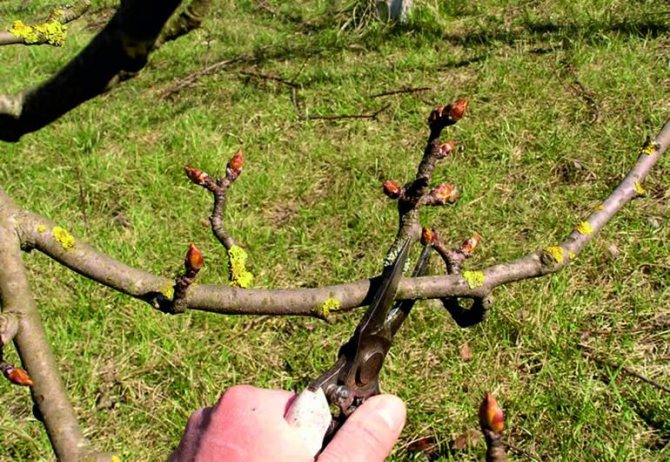

It is not recommended to prune the pear every year. In the fall, it is necessary to carry out a sanitary procedure, before the onset of frost. If frosts hit unexpectedly, then the pruning is transferred to the next spring - in the extreme cold, the wounds do not have time to heal, the tree freezes and may die.
The optimum temperature for the operation is about 8 degrees Celsius... Do not prune in late autumn; September is the best option. Since it is easier to collect fruits from the pyramidal crown, this should be taken into account when forming it.
Gardeners recommend forming the crown at the very beginning of the plant's life. This must be taken seriously, because it is at this time that the skeleton of the pear is created. An annual fruit plant should be pruned at a height of 45 to 55 cm from the surface. In two-year-old specimens, it is necessary to leave 3-4 skeletal branches, cut them at the same level, remove the remaining shoots. In this case, the conductor should be cut 20 cm above the main branches.
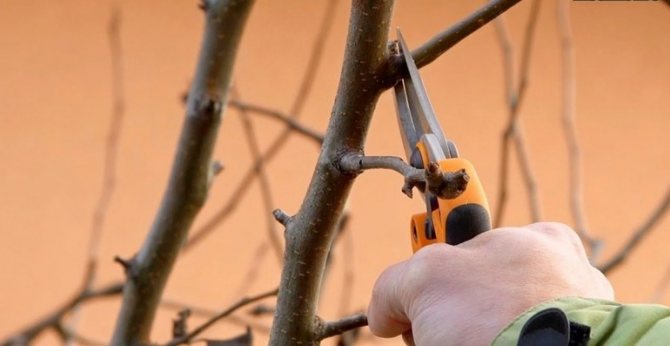

Autumn pruning of pears is of a sanitary nature: branches thickening the crown, old and diseased shoots are removed. It will not be superfluous to prune the annual shoots and crown a little if the tree is growing too quickly.After completing the procedures, you need to treat the wounds: grease the old branches immediately, and the young ones only after a day.
Old trees can be rejuvenated by shortening their tops if they are neglected. If the pear has undergone periodic processing, then you can not touch the upper branches, removing the old, dry, non-fruiting and broken parts. The remaining shoots must be slightly shortened, by about a quarter. At the end of the operation, all sections must be lubricated with garden varnish or drying oil.
Pruning trees in autumn for beginners in pictures
When getting started pruning trees, it is very important to navigate not only how to choose the right tools and time, but also which technology is best to apply to remove excess vegetation. But it is with the last point that novice gardeners most often have problems. The pictures presented here will help you better navigate which elements of the tree should be cut in the first place and what is the best way to do it.
branches to be deleted
Everyone knows that first of all, dry and diseased branches are cut. Then those that grow inside the crown or interfere with each other. Next, you need to look at the angle between the branch and the trunk.
The closer it is to zero (or 180 degrees if the branches are directed downward), the less these branches are prone to fruiting.
Therefore, experienced gardeners tend to leave (or form as such) as many branches as possible growing perpendicular to the trunk. After all, it is on them that the largest part of the "fruits" is formed, which are the basis of the future harvest.
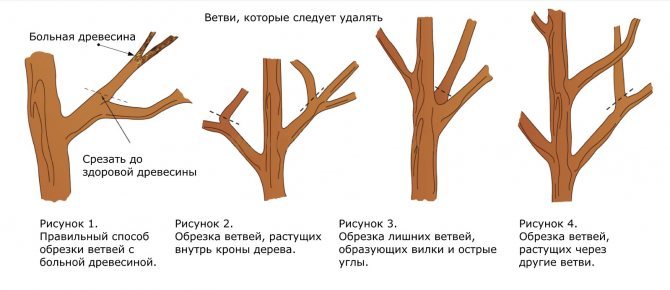

Advice!
In case of improper growth of frame branches, it is undesirable to cut them. It is best to stretch these branches with a rope and secure them. After 2-3 weeks, you can release them, or you can leave the tree in this state until spring.
features of cutting branches
It is important not only to determine the branches you need to delete, but to cut them correctly. In this case, the following techniques are used:
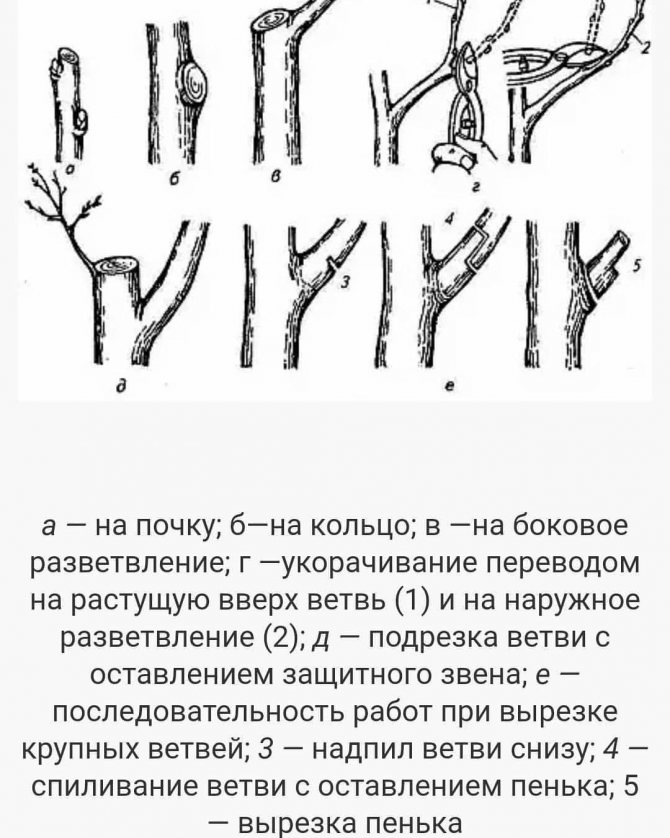

Thin branches are cut with a secateurs, for thick ones, a saw is used. It is important to keep the cuts as straight as possible on the tree, and to use the correct branch harvesting techniques. Errors here are fraught with a decrease in yield, the development of diseases and even the death of the tree as a whole.
Features of pruning trees and shrubs in the fall
The scheme by which fruit trees are cut in autumn is as follows. The crown of trees is thinned out. This provides the plant with better ventilation and UV saturation.


For seedlings, this procedure is carried out annually until the crown is fully formed. Only a few main branches are left on the trunk, all the rest of the young growth is removed.
For old trees, crown thinning is usually done every two years. All shoots that do not grow properly are removed. For example, straight up or down, intertwining with each other.
The shortening method is used so that the branches of the trees grow in the right direction, allowing the crown to form correctly. For this, the branches are shortened to a bud, which will ensure the growth of the shoot in the desired direction. The branches of fruit trees should be parallel to the ground. This greatly facilitates plant maintenance and harvesting.
In addition, it will be correct to remove all diseased, lichen-covered branches. It is best to do this in the fall. With the onset of cold weather, such shoots make the tree especially sensitive to frost. Accordingly, the plant will tolerate wintering much worse.
Do not leave dry branches either. With strong gusts of wind, they can break and damage fruit-bearing branches.
To remove dried out shoots, it is best to use a garden hacksaw. Remember that dry branches are removed mainly down to living wood tissue.
Garden, vegetable garden and flower garden tips
Planting days in September 2020 in the Urals
The growing moon in September 2020 when from what date
Lunar calendar for september 2020 moon phases favorable days for landing
Related Videos
About pruning fruit trees at different times of the year, their goals, sequence and conditions in the video:
It is possible to start pruning only with a full understanding of the processes occurring in the plant and the laws of its development, otherwise the interference is likely to be harmful. It is necessary to carefully study the rules for pruning this crop or invite a knowledgeable person - then the tree will bring abundant and tasty harvests for a long time.
For a novice gardener, there is always an acute problem when pruning trees in the garden, because such a procedure is one of the most effective ways to increase the yield of fruits, protect against pests and manipulation that significantly increases the life of the plant. If you approach the solution of this problem responsibly, you can correctly form the crown of the tree, which will give it an aesthetic appearance and ensure the flow of oxygen and solar heat to each individual branch, and this will have a positive effect on the amount of fruits grown. In addition, pruning eliminates the possibility of trees growing in width and height.
Pruning schemes
Pruning fruit trees can be carried out to achieve a variety of goals, therefore, the schemes for its implementation are also different. The main options that every gardener should know are discussed below:
- Formative pruning is carried out to give the crown the desired shape and then maintain the tree in this form. Particular attention is paid to the correct formation of the skeletal part, which greatly increases the resistance of the grown culture to various loads. It is very often practiced at the end of winter, which makes the spring regrowth of shoots even more intense and active. If it is necessary to achieve the opposite result and slow down the growth of branches, formative pruning, on the contrary, is implemented in March or April. You can start practicing it from the second year of the tree's life, after which the process stretches for several years. The technology for its implementation depends on the specific variety of the cultivated crop; this issue was discussed in more detail above.
- Rejuvenating pruning is essential to renew the entire tree and stimulate new shoot growth. First of all, the procedure is aimed at eliminating all old branches that are already beginning to dry out. To do this, near their base, it is necessary to find fatty shoots, move away from them no more than 1 - 2 cm and cut off the branch. After a while, the cut will need to be treated with garden pitch, it is desirable that several strong shoots are located near it, since this will have a positive effect on the wound healing process.
- Sanitary pruning is usually caused by the need to remove any parasitic or disease-infested shoots, as well as dry or broken branches. Removal of skeletal branches should be carried out exclusively on the ring, while shoots are cut off above the outer bud. All affected processes are eliminated along with the healthy part, since the likelihood of their survival is minimal. When pruning vertically arranged branches, it is necessary to leave an oblique cut.
- Regulatory pruning is carried out according to the same schemes., as the formative variety, since this procedure is aimed at maintaining and preserving the achieved result.


How to properly prune an apple tree in autumn, diagram
The apple tree is one of the most popular trees in our latitudes. Not everyone knows this, but it is capable of bearing fruit for about a hundred years. But this cannot be done without proper care, one of the elements of which is correct pruning.
The scheme of its implementation depends on the age of the apple tree and can be carried out in one of the following ways:
Together with them, thinning is also used, that is, cutting out the entire shoots.
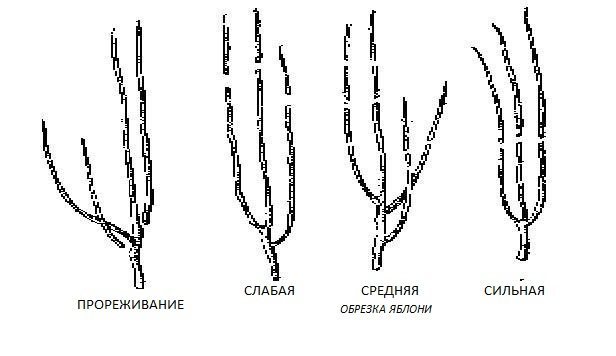

In the formative pruning of young seedlings, weak pruning is used with cutting out some shoots entirely. In this case, the central conductor should rise 15-30 cm above other branches. Skeletal branches are formed from 3-5 lateral shoots, shortening by a bud and leaving their ends at the same level. All competitors are cut to the ring.
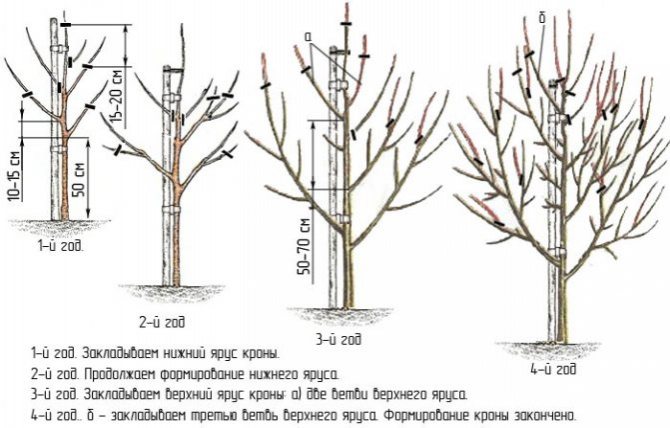

During the period of active fruiting (5-10 years), the main task of pruning is to activate the "fruits", and, accordingly, increase the yield. At the same time, strong thinning is combined with weak (or medium) shortening. In this way, they regulate the density of the crown, as well as the growth and the desired direction of the overgrown branches.
The video will help you better understand all of the above:
Older apple trees need rejuvenation. At the same time, strong pruning of apple trees is used: the skeletal branches are cut to the zone where tops appear, and the crown is partially thinned out. The procedure improves the conditions for fruit ripening, which has the best effect on their quality. Branches that need pruning during rejuvenating pruning of old apple trees are perfectly illustrated by the diagram:
Slicing types
In order to correctly prune fruit trees in the fall, you need to have certain skills and know how to remove one or another shoot. Incorrect or inaccurate removal is more likely to harm than benefit.
When pruning, the following methods are used:
- Ring cut. This implies the complete removal of the shoot in the place of the annular influx from which it grows. You cannot leave a stump in the place of the cut, since a top shoot will grow from it. And also you cannot make a long deep cut, which will take a very long time.


- Kidney cut. In this way, as a rule, one-year growth is shortened. The cut should start at the base of the bud and end at the top of the bud. If the cut is made longer, the shoot will grow weak or die.


Important! Above the kidney, a small spike with a length of 1.5-2 cm can be left to prevent deep death, which will also affect the kidney. After a full-fledged shoot grows out of the bud, the thorn can be removed. - Side branch cut. It is used to change the direction of growth of a branch, transferring its growth from the main to the side. It is used to restrict growth, crown formation.
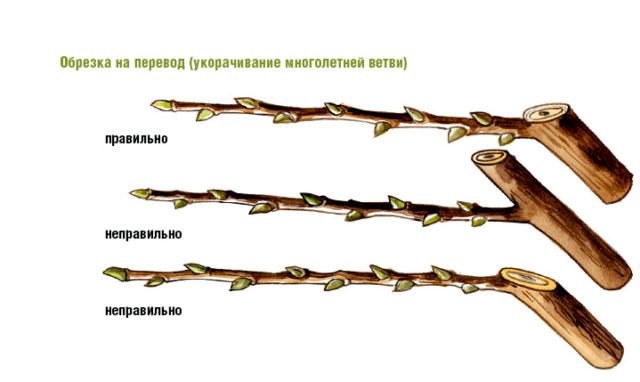

In this case, the cut is performed parallel to the direction of growth of the shoot, to which the main one is transferred.
Places of cuts are cleaned with a garden knife and processed with garden varnish. This will prevent pathogens or fungal spores from entering open wounds.
Rejuvenation of apple trees
Anti-aging pruning is done for trees over 20 years old... Before pruning, you need to make sure that the trunk and the main skeletal branches of the tree are viable, that there is no wood rot and disease.
Cron, usually, divided into several zones, where consistently (for several years) carry out strong pruning.
This ensures the successful restoration of the tree after the traumatic procedure, the gradual growth of the crown and increased fruiting.
Rejuvenating pruning of apple trees in the fall is carried out according to the following algorithm:
- In the fall, pruning is carried out on the south side above the outer buds;
- The next year, the same pruning is used on the second side, and also the vertically growing shoots formed during the year are cut off.
Pruning starts with removing all branches growing inward and vertically, as well as dry, old, sick, naked, infertile branches. Thus, the crown is thinned out.
It must be remembered that when rejuvenating, it is better to remove one large branch than many small.
Then carry out opening of the center of the crown:
- The trunk is shortened at a height of 3-3.5 meters from the trunk;
- Branches and twigs above the young shoots are cut;
- The tops growing towards the center are removed, the tops directed outward from the trunk (about 10 pieces evenly spaced throughout the tree) are pruned.
As a result of pruning from next spring, new shoots, deciduous mass will increase, will improve nutrient intake from the root system.
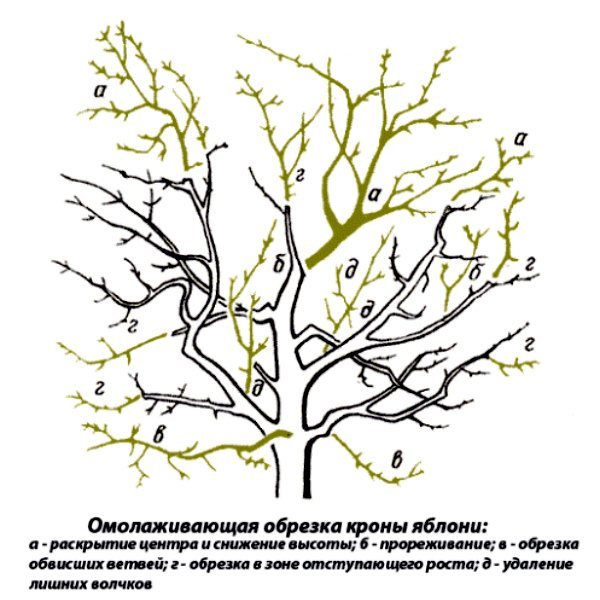

Anti-aging pruning scheme.
ATTENTION! Rejuvenation of adult apple trees is carried out once every 5 years.
How to do a rejuvenating pruning of apple trees in the fall - video below:
Types of apple pruning
How to prune apple trees in the fall depends on the goal. It can be a procedure for rejuvenation, crown formation, prophylactic or stimulating fruit formation.
Formative pruning
Crown formation in young apple trees is usually carried out in the spring, but if the region is warm and the seedling does not risk freezing, this can be done in the fall. The essence of formative pruning is to make the arrangement of the branches as convenient as possible for care and harvesting. In this case, the top is cut off, and the side branches leave those that grow parallel to the ground.
Sanitary pruning
Sanitary pruning of apple trees in the fall is carried out annually. You must first remove all dry or lichen-affected shoots, cover up the sections. Sanitary measures include improving ventilation inside the crown. For this, small branches are cut if they thicken the crown. Most of these shoots are formed in summer.
Regulating fruiting
You can improve fruiting by pruning an apple tree in a lean year, when more nutrients are stored in the plant tissues. For this, large branches are removed, on which fruits are tied worse. Such an event must be combined with deep watering of the soil and top dressing with complex or potassium-phosphorus fertilizers.
If the apple tree does not bear fruit for a year, you can make an attempt to grow new branches. To do this, they find dormant buds on the trunk and make a triangular incision deep into the cambium to block the movement of juices. They will accumulate below the incision, where the dormant kidney is located, and stimulate its growth.
Restorative pruning
It is necessary when the tree has been damaged for any reason - wrong pruning, hurricane, illness. The gardener's task is to correctly form the crown, ensuring the vitality of the apple tree. For this, minimal intervention is carried out, cutting off only unnecessary growth that thickens the crown.
Anti-aging pruning
A radical procedure that is carried out with adults, but healthy trees. It is not worth wasting time if the plant is severely affected by fungus or rotting from the inside. Large branches are removed, then crown thinning is carried out on those that remain. There is no point in counting on a large harvest after such an intervention - the tree must recover and redirect the movement of sap along new paths.
How to prune a pear in the fall
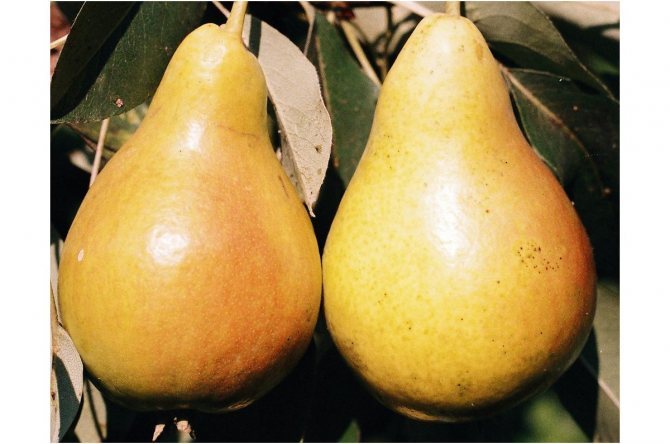

Like the apple tree, excess growth is also removed from the pear, which often naturally forms a well-shaped crown with a central conductor. Usually it is not as thick as that of an apple tree, therefore it needs a similar, but less powerful pruning. In addition, since the tree has a tendency to freeze in winter, it is poorly pruned.
But due to the fact that part of the active buds of the pear dies, the sleeping ones wake up. And among them, a lot of tops are always formed, on which the gardener must definitely work. By shortening such shoots, they turn into semi-skeletal and overgrown branches. All the rest are removed so as not to interfere.
Attention!
According to experts, it is the autumn pruning of pears that brings the greatest benefit to the tree.
Only early and medium pears are processed in this way.
In the first year after planting, the seedling is not pruned.
Increased yield
Novice gardeners are often interested in how to increase the yield of garden trees. In this case, professionals noted that horizontal branches produce the largest yield. In addition, autumn pruning is in part aimed at increasing fruiting.
When carrying out the procedure, it is not necessary to remove incorrectly growing frame branches, otherwise the harvest will not be for a long time. They can be stretched by fixing them with a rope. This is done easily: the branch is pulled in the desired direction with a rope, to the maximum possible angle so that it does not break, and is fixed. After two weeks, the rope is untied.
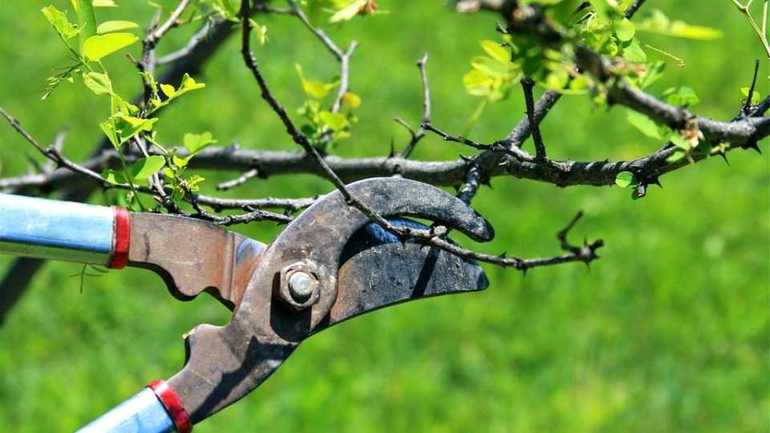

The operation is carried out with all the main branches that form the crown. Thus, by the next season, the crown will grow correctly, which will lead to an increase in yield.
How to shape the crown of fruit trees
There are quite a few ways to form the crown of fruit trees. These include the following:
- sparse tiered;
- bowl-shaped;
- fusiform;
- fan;
- bush;
- tierless.
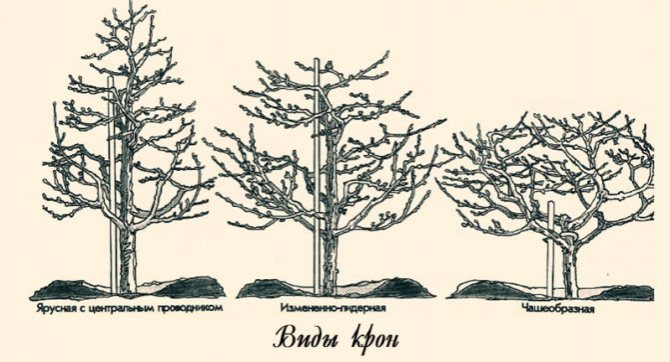

The sparse-tiered crown is formed from the moment the seedling is planted and lasts for several years. With the help of pruning, a higher fruit layer is laid each subsequent year. The formation of the crown is usually completed in the 4th year, after the laying of the 3rd tier. In the future, only supporting, regulating and sanitary pruning is carried out.
The bowl-shaped crown allows you to lighten and saturate the center of the tree with air, which is why such pruning is used for sun-loving plants such as peach or apricot. With this method of pruning, the tree lacks a central conductor, and the skeleton in the form of a bowl forms branches extending from a short stem.
The spindle-shaped crown is formed mainly on dwarf rootstocks. In this case, an even central conductor is left, and skeletal branches are completely absent. All fruiting takes place at 2-3 year growth, which is constantly renewed.
Fan and bush forms are used on low-growing crops. In such plants, there is no central conductor; instead, several equivalent shoots are formed. The fan shape is used more for berry bushes, but the bushy shape of fruit trees is not at all uncommon.
A tierless crown is formed quite simply. For this, a central conductor (leader) is used, around which skeletal branches are laid at a certain distance (25–40 cm). After the tree reaches a certain height, the last skeletal branch is laid, to which the growth is transferred, removing the leader.
Pruning goals
Observations show that most of the fruits are formed on those branches that are located horizontally. To form the crown of apple trees correctly, pruning is carried out regularly, starting from the moment of planting.
If the tree is adult, it is not recommended to touch the frame shoots: this is a serious stress for the plant, and it may not yield a crop. In this case, a rope is tied to an incorrectly growing branch and tilted in the correct direction, tying the rope to an iron peg. She will be in this position for 2 weeks, then the rope is pulled up and left again. The apple tree can be in this position until spring, then the device is removed.
They cut down unnecessary shoots so that food is not wasted. Young shoots rarely produce a crop - apples are formed on two- or three-year branches.
How to prune plums in the fall
Specialists have different opinions regarding the autumn pruning of plums.Supporters complain that due to the vagaries of the weather in the spring, you simply may not have time to do this procedure. Opponents, however, appeal to the fact that mistakes made at this time can become fatal for the tree.
Indeed, autumn cuts do not tighten well. The reason for this is the suspension in the growth of cambial cells. Based on the above, it is best to carry out only sanitary pruning of plums in the fall. When preparing a tree for winter, it is imperative to remove dry, diseased and broken branches from it, and in some cases also to thin the crown so that it is not injured from a large amount of snow.
Mistake # 5: pruning early flowering crops in the fall
In some perennials, flower buds are laid in the current season - for example, in lilacs, some types of clematis, forsythia, honeysuckle, viburnum buldenezh, jasmine. Autumn pruning deprives the plant of its spectacular appearance in spring, abundant flowering, and you should not wait for a harvest either. Plants with this growing season are preferably pruned immediately after flowering. Sanitary pruning is possible in autumn, and formative in spring.
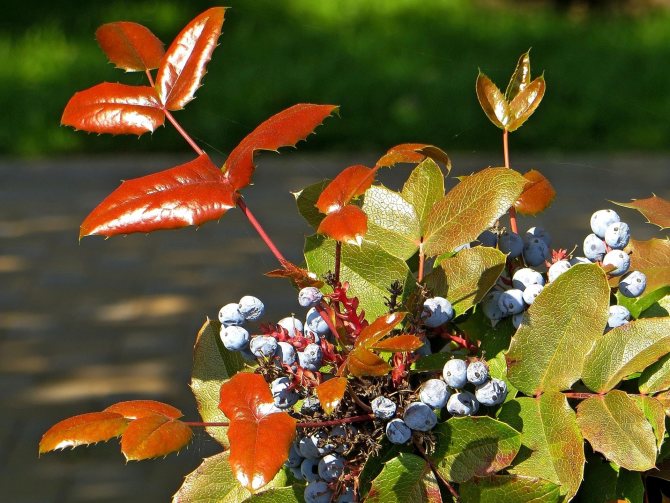

Mahonia bushes with glossy dense leaves are attractive all year round, so the plant should not be pruned for the winter.
Herbaceous perennials with evergreen leaves cannot be cut off (hellebore, saxifrage, mahonia, boxwood). This greatly weakens the plants and can lead to their death. Gradually dying old foliage is removed as needed in the next season.
Effect of pruning on the condition and fruiting of the tree
In some way, each pruning is stressful for the plant, but it can be used to regulate the time of fruiting and the overall development of the tree trunk. Remember, every coin has two sides, for example, if you eliminate branches that grow in the wrong direction and add excessive density to the crown, while not applying the shortening of the one-year growth, then this strategy will significantly speed up the time when the tree begins to yield. Especially when compared to instances to which such methods were not applied. However, this is fraught with the fact that the crown will be ankle and unstable, and the branches will be characterized by weakness and a small interval of life, which differs little from a representative of the flora that has not been cut off at all.
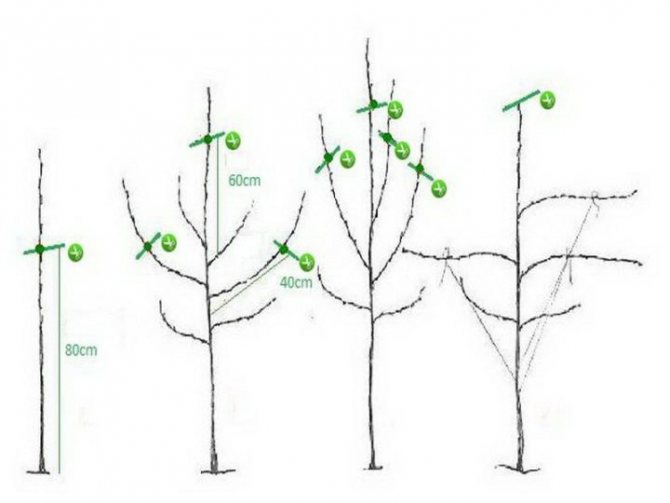

Inexperienced gardeners often sin when pruning by greatly shortening the branches. If in a young and actively growing nut one-year-old growth is shortened in large quantities and without any reason, this will lead to unnecessary crown density and a delayed onset of fruiting. If the variety is characterized by fruits at the very end of long branches, then fanatical shortening will lead to a significant decrease in the amount of fruit. In addition, you should be aware that thoughtless pruning reduces the tolerance to cold in the winter. Strong pruning is only justified if the plant is young, but its growth is weak.
It should be borne in mind that if you combine a tenderloin with a slight or medium pruning of one-year growth, then this will slightly delay (maximum - by 2 years) fruiting during the first couple of harvests, but not their level as a whole. The advantages of this will be a superbly folded crown, which is distinguished by its strength, besides, the branches will be more stable, and the fruits on them are larger.
If the gardener wants to achieve that the fruits are invariably large, it is necessary to intensively prune the annual growth every year, however, take into account that the total yield from a particular tree will significantly decrease. In such trees, the crown becomes dense, you have to spend a lot of time eliminating unnecessary branches, which will weaken the yield potential.
Cherries and sweet cherries
Cherry is a plant that does not need an annual procedure, but if such a need arises, then most often pruning is carried out in the spring... In the fall, only sanitary operations are carried out.The exact time depends on the region. In the warm - this is October, in the colder - the month of September. The reference point after which you can do pruning is the discarding of leaves. However, if frost is predicted in the near future, it is better not to risk it and cut the cherry in the spring.


Avoid pruning one-year-old cherries in the fall, as they may not withstand the cold. Mature trees are subjected to a standard procedure, removing old, diseased and damaged parts. You also need to remove all the growth in which small rodents and insects can live.
For cherries, pruning is not much different from pruning cherries. However, you should be aware that intensive removal of branches in the fall reduces the yield. You can experiment a bit with the anti-aging procedure and prune in the fall. If the result is not satisfactory, then next time it is better to do it in the spring.
Experienced gardeners recommend forming the crown of a sweet cherry in the form of a cone - the tree receives more light, and the air circulates more actively between the shoots. The conical shape is not the only one, you can still use a bowl-shaped or tiered version.
How to prune currant bushes in the fall


All types of currants are pruned during the dormant period, when the shrubs have no leaves or buds on them. At the same time, no more than 10 large branches are left on young bushes. On those that have already entered fruiting, about a third of the oldest shoots are removed. This is done at the root, at the very ground. By the way, in a similar way, they get rid of unripe shoots, which, when frozen, significantly reduce the immunity of the plant as a whole. The remaining branches, for better branching, are shortened to the first bud.
Branches of black currant bear fruit best at 3-5 years, and white and red - 2-5 years. Then they gradually lose their yield. Therefore, all aged branches are subject to mandatory removal. But at the same time, it is imperative to take care of new ones, leaving 3-5 ripe replacement shoots every year.


Advice!
After removing shoots from currant bushes, they need hilling. After all, new branches must sprout from the roots.
Everything related to pruning red and white currants can also be used for gooseberries.
Pruning young and old trees
Young fruit trees
The age of trees has a significant impact on the characteristics of their pruning. Below is comprehensive information regarding this procedure for young seedlings:
- Pruning begins before the first harvest, its main purpose at this stage is to form the crown. For this, the gardener must establish the process of the formation of skeletal branches and carefully monitor the growth process of all young shoots.
- During the active growth of trees at a young age, the gardener must make every effort to grow the crops grown in width, and not upward. For this, all fresh shoots, whose age does not exceed a year, are shortened, and the shoots that contribute to the thickening of the crown are completely eliminated.
- All shoots that are too fast and too active should be shortened by exactly half. Weaker and less developed branches are cut off by no more than 25 - 30% of their total length. This must be done without fail, since in the future it will be much more difficult to form a strong crown, and this is the main requirement for ensuring a high level of tree productivity.
- All branches that cross or have other close contacts with each other must be removed.
Old fruit trees
Old fruit trees are pruned in a completely different way, since they do not require crown formation. During this process, you must adhere to the following rules:
- All crops, except those that do not tolerate heavy pruning, may experience significant seasonal pruning. Most gardeners recommend reducing them by 3 to 5 times, depending on the height of the tree. It is necessary to abandon this practice only when growing fruit crops in regions that are characterized by severe winters or significant changes in temperature regimes.
- Inhabitants of cold areas can carry out not instant, but gradual pruning, every year more and more shortening fruit trees. After 2 - 3 years, this will allow a significant reduction in their size. At the same time, even the largest branches are not allowed to be shortened by more than 2 meters at a time. It is also necessary to take into account that this technique will negatively affect the harvest, an increase in its volume will occur only after 5 years.
- A more modern way of pruning old fruit trees is to significantly shorten only their southern side, the size of all branches on it is halved. This can be done only for trees whose height is at least 3 meters, while you need to keep within the period preceding bud break. Top shoots, if they are strong enough, can be preserved, but the distance between them should be at least 70 cm. In subsequent seasons, it will be necessary to maintain the trimmed side of the crown in the same condition.
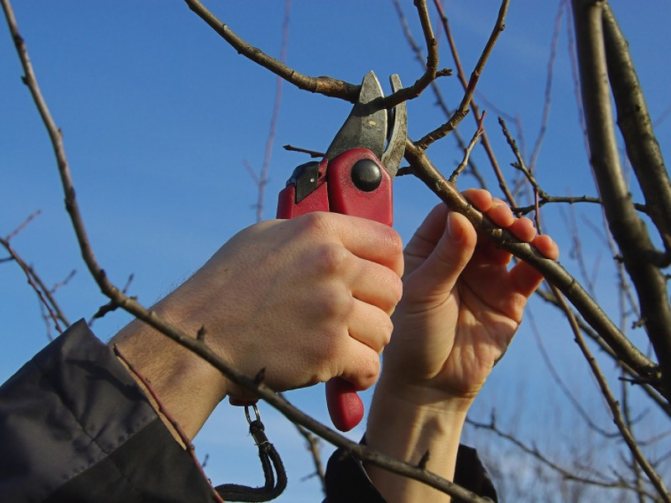

The need for pruning for old apple trees
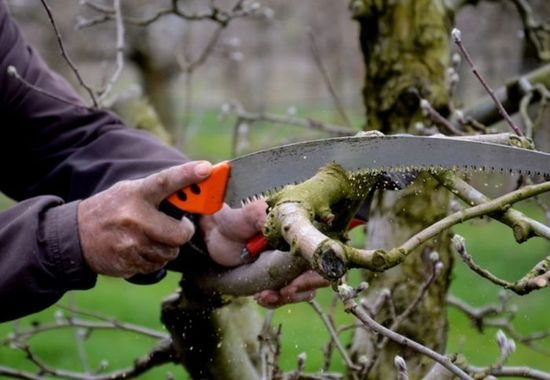

If the growth of the apple tree is not controlled, the overgrown crown shades the space around and stops bearing fruit. Old trees die without timely pruning. As a result of the correct formation of the crown, the old shoots are gradually replaced by young branches that consistently yield. The distribution of nutrients is more rational. Therefore, the yield of old apple trees increases after rejuvenation.
In a fruit tree with a properly formed crown, the illumination of all branches improves. As a result, the fruit ripens evenly. In the crown, freed from excess greenery, air circulates freely. This protects the plant from spreading infections and infestation by insect pests. With proper rejuvenation of old apple trees, beautiful trees with a neat crown are obtained in the fall. They bear fruit better and produce tasty, large fruits.
Sanitary pruning
No matter how competent your garden care is, some shoots will still die off, others will not fully develop, and others will acquire an ugly shape, spoiling the decorative appearance of a tree or shrub. Therefore, it is necessary to carry out annual sanitary pruning in the garden, regularly removing diseased and old shoots, which will soon be replaced by young ones.
When pruning thick branches and trunks, do not forget to treat the cut with garden pitch, this will allow the plant to heal its wounds faster and somewhat reduce the risk of parasites, insects or mold.
How best to prune grapes in the fall


Autumn pruning of grapes is one of the mandatory procedures for this culture. At first glance, the operation is quite complicated, but if you neglect it, the plant will throw all its strength into the formation of the vine, and then you will simply have to forget about the harvest. Therefore, every novice wine grower simply needs to master it.
They begin to form a grape bush only after it completely gets rid of the foliage, but before the onset of stable cold weather. For good productivity and early fruiting, two main shoots are formed on the grapes immediately after planting.
In the second year of life, in order for the seedling to gain strength, it is shortened by two buds, and in the summer, the excess is pinched. In the third year, removing all unnecessary bends, the fruit link is finally formed: a sleeve-knot of replacement-vine of fruiting.
Attention!
The pruning length of vines for each variety is different and depends on its characteristics: short - for 4 buds, medium - for 4-8 and long - for 8-12, and sometimes up to 20 eyes (by the way, the first two can be ignored).
When performing the procedure, all the cuts left on each of the sleeves should be on one side. Otherwise, circular tissue necrosis may occur, which will lead to the death of the plant.
The formation of a grape bush in the first two years of life is as follows:
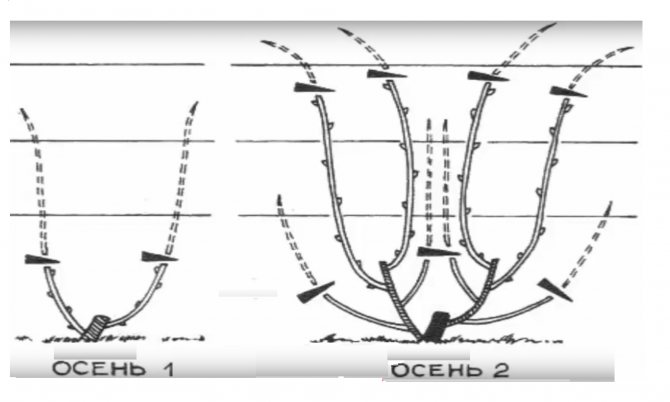

In general, starting from the third year, the scheme of autumn pruning of grapes looks like this:
- All fertile vines, spinning tops, as well as weak and interfering shoots are cut off.
- In young bushes, all unnecessary branches are removed, in old ones - annuals.
- Fruiting vines are shortened depending on the individual characteristics of the variety. Replacement knots - 3-4 buds.
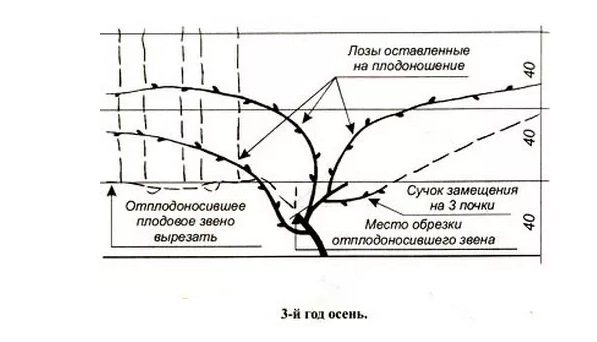

Advice!
Without knowing exactly which variety you are pruning, in order to accurately get into the fruiting zone, it is best to prune 6-8 buds.
The weaker the shoot, the fewer buds are left on it.
Top shoots are cut out both completely and on a replacement knot.
When pruning in autumn, it is advisable to leave 2-3 times more shoots than necessary. This is due to the possibility of their freezing. In the spring, all unnecessary must be removed.
Pruning ornamental shrubs in the fall
Autumn pruning of ornamental shrubs directly depends on the time of their flowering. And if sanitary pruning is carried out in the fall to all shrubs without exception, then shaping (with shortening of the shoots) will not harm only the crops blooming on the shoots of the current year.
In order not to be mistaken, you need to remember that in the fall you can only cut shrubs that bloom in mid-summer, for example:
- some types of spirea blooming in summer;
- panicle hydrangea;
- hydrangea;
- buddley of David;
- fieldfare;
- goose cinquefoil and many others.
I have listed the most common ornamental shrubs that bloom on the shoots of the current year. But in fact, their list is much more impressive. If you have ornamental shrubs that you do not know how and when to prune correctly, in the fall it is better to limit yourself to sanitary pruning, and carry out the main haircut after flowering.


During the autumn pruning of roses, at least all branches growing inside the bush, damaged, weak and immature shoots, are removed. <>
Features of pruning rose bushes
In most of the territory of our country, roses winter under cover, so autumn pruning is simply necessary for them. Pruning is carried out in mid-autumn in dry, clear weather. First, remove all branches growing inside the bush, damaged, weak and immature shoots. In the grafted varieties, all root shoots are removed.
There are several ways of pruning roses - with strong pruning of branches, medium and low. Most often, gardeners use the second method, cutting off the shoots above the fifth or sixth bud. An important nuance - the bud must be outside, otherwise a new shoot will grow inside the bush.
Climbing roses in the fall should not be greatly shortened, it is enough to carry out sanitary pruning and remove flowers and buds.
Dear Readers! Autumn pruning of trees and shrubs is a necessary stage in plant care. Correctly executed pruning in compliance with the terms contributes to good development, preservation of immunity, increased productivity and well-groomed appearance of plants. Therefore, do not ignore this event when it is necessary.
Why is autumn pruning important?
During the spring and summer seasons, fruit trees actively branch, new buds are formed on them. All these processes, to a certain extent, contribute to the growth of the crop, but if you lose control over them, the trees will "get entangled" in their own branches and will not be able to properly allocate resources, which will lead to the production of meager and unpalatable fruits.
Since the “bigger is better” law does not apply to plants, it is important to maintain a limited number of branches that do not interfere with the development of the tree and are able to bear fruit well. The main purpose of autumn pruning, in turn, is to diagnose the condition of the tree after harvest. With a drop in temperature and falling foliage, the gardener will have to decide which branches to get rid of and which ones to leave until the next warm times.


When processing branches, you should leave the strongest and most fertile
After the leaves fall, the tree goes into a state of dormancy, which means that it will take less time to "heal" the wounds left after the pruning shears compared to summer pruning. Summer pruning is dangerous, primarily due to the fact that the hemp remaining after the adjustment remains wet for a long time, creating favorable conditions for pathogenic bacteria and fungal infections.
Secateurs prices
secateurs
Trimming time
It is worth repeating again that autumn pruning can bring both positive and negative effects, depending on temperature indicators:
- Inhabitants of the southern regions, which are not threatened by the early onset of frost, prune fruit trees in September-October. If desired, gardeners who are lucky with a mild climate can process the necessary plants all year round, including from October to March. However, it should be borne in mind that too frequent pruning does not allow the tree to recover and can cost you not only a rich harvest, but also the life of the plant;


Autumn pruning is carried out only at a consistently high temperature that does not fall below zero
- Residents of the northern regions are advised not to think about the autumn pruning of trees at all, since the likelihood of negative consequences is high. If the bark freezes over in the area of the wound inflicted on the plant, then the process of desiccation may begin, gradually taking over the entire tree. In terms of the degree of impact, it can be compared with necrosis of living tissues.
Do I need to whitewash trees in autumn
For experienced gardeners, the answer is definitely positive. And the main reason here is far from aesthetic appeal, which is often motivated by spring whitewashing. The fact is that such a procedure helps the tree more easily withstand sudden temperature changes, and, accordingly, get out of hibernation with less losses.
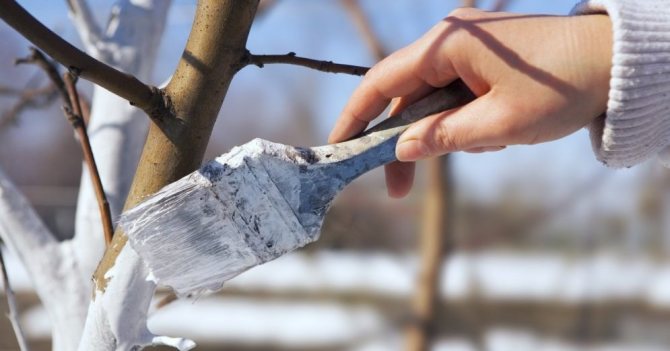

Otherwise, gardeners have to deal with frost cracks. These lesions of wood, most often, occur at the very end of winter, when the sun is already shining with might and main during the day, and frosts return again at night. Such crevices themselves practically do not heal. It is necessary to treat them for a long time and persistently. If this is not done, the tree weakens, and eventually dies.
Contrary to popular belief, trees of all age groups, without exception, need to be whitened. But in the case of young seedlings, it is necessary to avoid solutions containing lime or limit its amount in whitewash mixtures as much as possible. With respect to old trees, the painting process becomes much more complicated due to the large amount of pre-painting work.
Advice!
It is advisable to carry out painting work before the very frosts, so that such a coating lasts as long as possible on the tree trunk.
The stem and skeletal branches are to be stained. Moreover, the higher the tree is whitewashed, the better.
High whitewashing of the garden is most conveniently done with a sprayer.
How much to trim?
Do not cut more than 25% of the tree branches. When deciding how much to trim, you need to focus on the bare minimum.
Each pruning puts a lot of stress on the tree and increases its vulnerability to disease and insects.
Make sure the live branches are at least 2/3 of the tree's height. Removing more than necessary will increase the risk of damage to the tree. Sometimes pruning is forced.For example, wind damage, height reduction due to power lines, municipal crown raising requirements, etc. Even so, trim as little as possible.
How to whiten trees in autumn
For the autumn painting of trees, a variety of mixtures are used: water-based emulsion, water-dispersion paint, as well as well-known lime solutions. The main requirements for whitewash compositions are the coloring of the surface in white, the ability of the skin to "breathe" under them, as well as the duration of stay on the bark.


The modern industry offers a wide range of tree whitewash. But you can also cook them yourself. In this case, the composition used for staining should include the following components:
- white clay, lime or chalk - to make it white;
- glue, milk or soap - for better adhesion to the bark;
- fungicide - for disinfection.
Attention!
When using commercial paint, be sure to make sure that it is intended specifically for whitewashing living trees, and not for any other wood.
But whitewashing itself is only the final step in a four-step process. It is preceded by cleaning the barrel, disinfecting it, and healing wounds.
The importance of pruning for the life of the tree
Each season is a special stage in the life of a fruit tree, pruning performed at different periods affects the development of the plant in different ways. The autumn procedure prepares the crown for wintering, carries a sanitary load. In summer, the plant actively absorbed solar energy, synthesized it into sugar, and produced a large number of fruits.
As the cold weather sets in, sugar from the leaves moves to the roots for winter storage. Heavy pruning during this period can harm the woody organism, because it will not have time to completely heal the wounds.
It is important to use sharp tools such as pruning shears and saws. Dull blades lead to deformation of the branches. Rubbing, crossing branches, as well as shriveled and diseased shoots are removed.
Branches weakened by infection become a source of disease for the entire plant, insect pests settle in them under the bark, and fungal colonies develop. During autumn cleaning, you can remove excess growth, but not too abundantly, as this can weaken the tree.
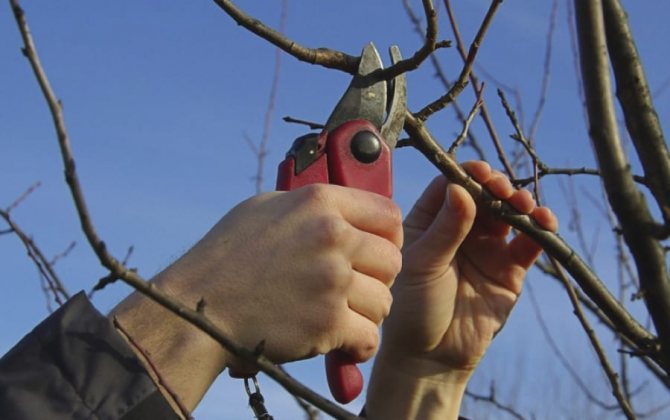

Pruning in winter
In the southern regions of Russia, pruning can be done even in winter. This is explained by the fact that the frosts in the south are much milder, as in the northern regions.
Winter pruning is primarily done in order to rejuvenate old trees and give the crown of the correct shape to young seedlings.
In addition, winter pruning is often done to reduce the production of young crops. Gardeners know that those specimens in the garden that give bountiful harvests in a row for 2-3 years need to be allowed to rest.
From a high yield, the thin branches of a young tree may well break. In this regard, it is important to cut off excess branches in winter. In the cold season, gardeners undergo crown-forming procedures, first pome breeds, and then stone fruits.
The ideal sizes for fruit bearing plants are 3 meters high and 3 meters wide. They will make it possible to harvest the bulk of the crop without the use of ladders or stepladders.
Pruning methods
Pruning fruit trees has a variety of uses. Gardeners distinguish several main pruning methods:
- Formative. It is considered the most important. Promotes the correct formation of the crown and determines the general shape of the trees on the site. It is carried out in early spring, before the juice begins to move.
- Regulatory. It is necessary for correcting an already formed crown. Extra shoots that overload the tree and prevent good lighting are removed. The period is in summer time.
- Recovery. It is carried out if the plant needs rehabilitation.Dry, damaged branches are removed. Thus, the influx of nutrients to the renewed shoots is enhanced.
- Anti-aging. Allows old trees to renew themselves, to increase the growth of young fruiting shoots. Promotes the awakening of dormant buds, activates flowering. Held in early spring.
- Sanitary. It is intended for the prevention of diseases and the healing of trees damaged by external factors. Plants can become infected with fungus. The branches begin to dry, the bark turns black and flakes off. So that the tree does not die completely, all diseased shoots are removed. Some branches can be broken by the weather and begin to die off and should be removed as well.


When to prune fruit trees
Such spring and autumn pruning is performedand fruit trees in temperate regions. But in the northern regions in the fall, when there is already a chance of frost, it is not recommended to carry out such manipulations with trees and shrubs.
The timing of the autumn pruning will directly depend on the climatic features in your region. It is best to do this work in October, when the trees have shed their leaves, the harvest will be harvested, but there will be another 2-3 weeks before frost.
Autumn pruning of apple trees
It is necessary to carry out autumn pruning of apple trees after complete foliage and harvest. Usually this work is done by gardeners in October and November. All broken, rotten and old branches are removed. Experienced gardeners recommend removing shoots growing close to each other, which leads to a significant thickening of the crown. All shoots that grow at an acute angle or are directed towards the inside of the crown are removed.
All cuts after performing such a pruning of the apple tree should be treated with varnish-based paint or garden varnish... Existing wounds on dry branches should be treated immediately, but hemp from young shoots is covered with pitch only after a day.
With the right timing of this procedure, the apple tree will easily tolerate such pruning, and next year the growth will significantly improve, numerous new shoots will appear, the correct crown will be formed, and subsequently the gardener will be able to get an excellent harvest with the apple orchard.
Correct pear pruning
One of the features of pear pruning is that it is recommended that such work be done in a year... Sanitary autumn pruning of such fruit trees is allowed only with a stable plus and the absence of the danger of frost in the coming weeks. Remember that in cold weather, pears should not be pruned, since such trees do not tolerate frost well, subsequently they get sick a lot and bear fruit poorly.
With formative pruning, the top is shortened and no more than five main lateral skeletal branches are left, forming a pyramidal crown. Rejuvenating pruning should be done every five years to avoid thickening and maintain yields.
Correct autumn pruning of plums
Plum and other stone fruit trees will require proper attention from the grower. Correct autumn pruning will ensure high-quality preparation for winter sleep, and in the future, such trees grow actively and bear fruit well. This work should be done immediately after the foliage has fallen, no later than the first days of November.
Pruning plums in the fall is not particularly difficult:
- All damaged, diseased and dried branches are removed.
- The top, which has grown by 2.5 meters or more, should be shortened.
- Remove competing shoots and all actively growing branches.
- Young shoots are cut to 1/3 of their length.
Pruning fruit trees
Autumn pruning of fruit trees will significantly improve the fruiting performance of the garden.It is necessary to carry out such work with cherry plum, irga, sea buckthorn, quince and viburnum only after the foliage has fallen off. We can recommend that you limit yourself to only the necessary measures, remove damaged branches and shoots growing at right angles to the main crown.
If rejuvenating pruning of fruit trees is needed, then it is allowed to remove one or two skeletal branches, and all branches that are already 5 years old and which practically do not bear fruit are also pruned. Subsequently, planting after performing such a rejuvenating pruning quickly regains its yield indicators, which persist for 5-7 years.

